Montreal
Montreal Super AdminMaps of Montreal show seven corridors: Highway A-40 (three segments), Highway A-10/A-15, Highway A-20/A-25, Highway A-30, and Highway A-20, with travel time index (TTI) data color-coded for each corridor.
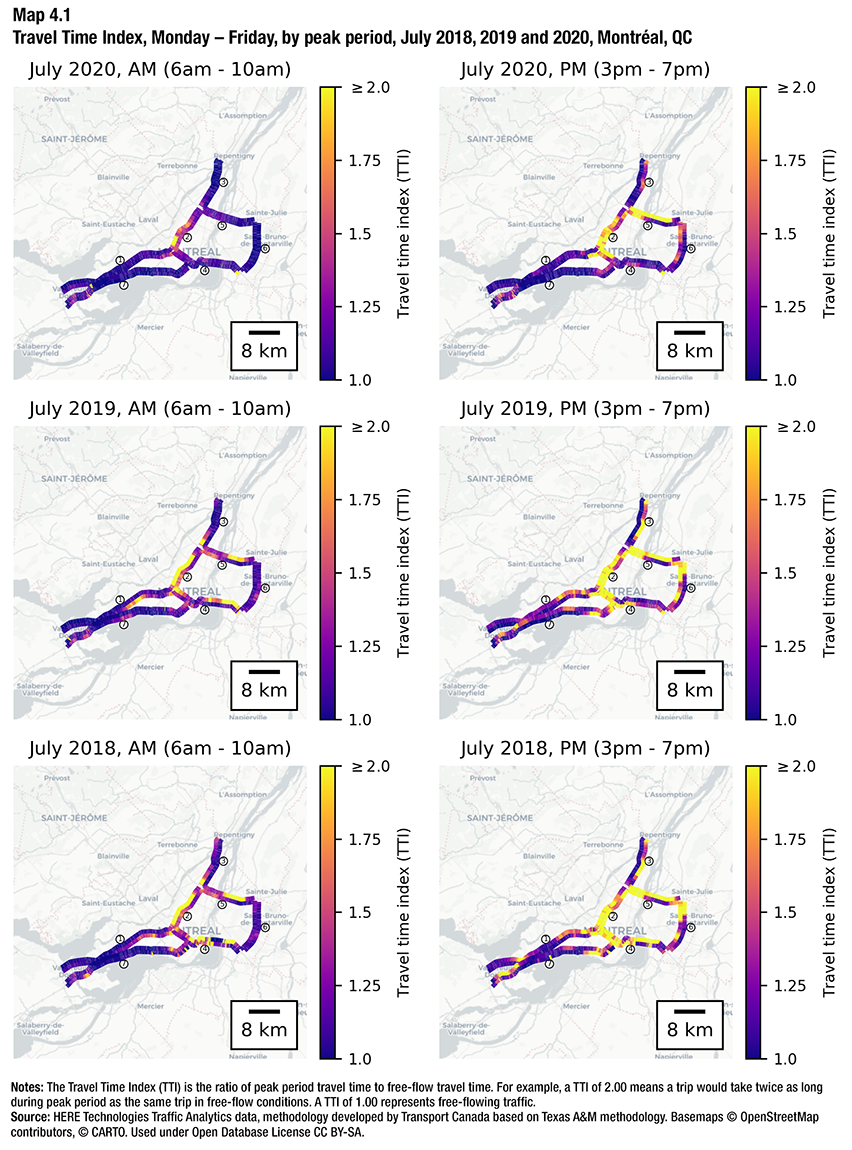
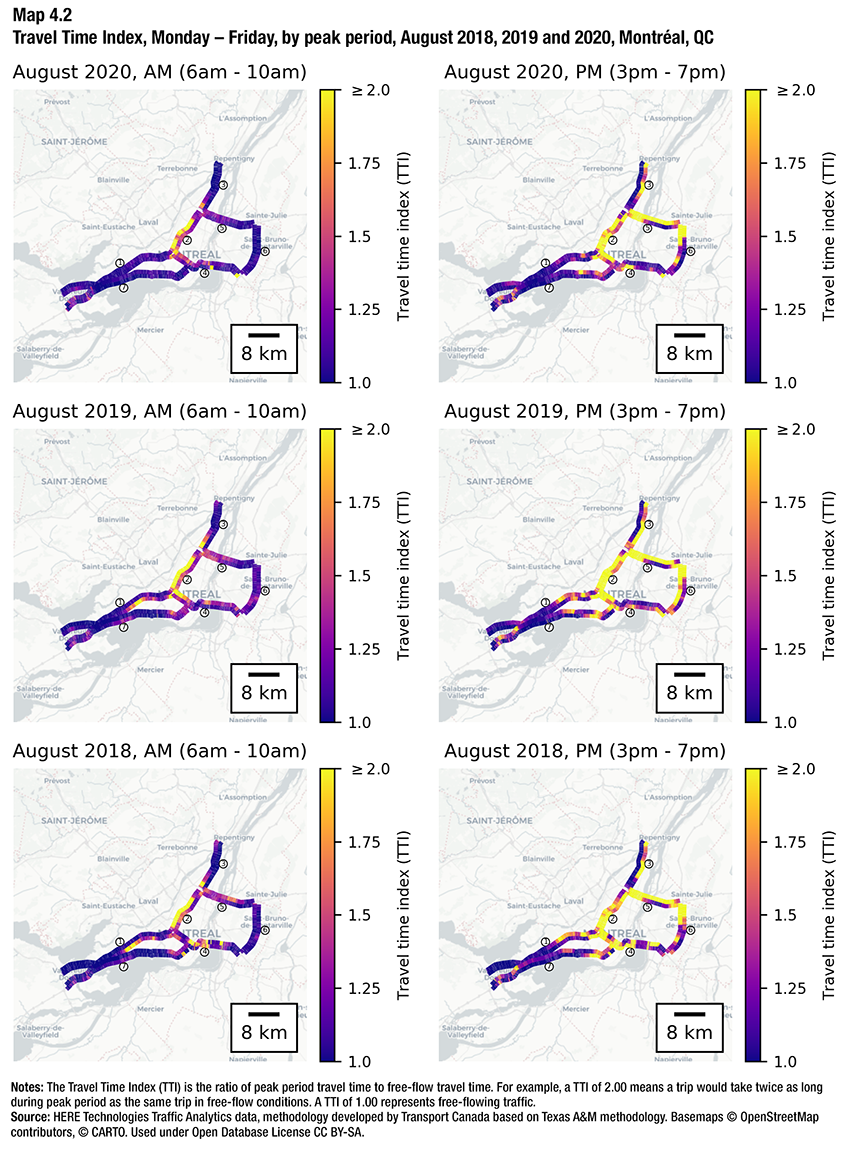
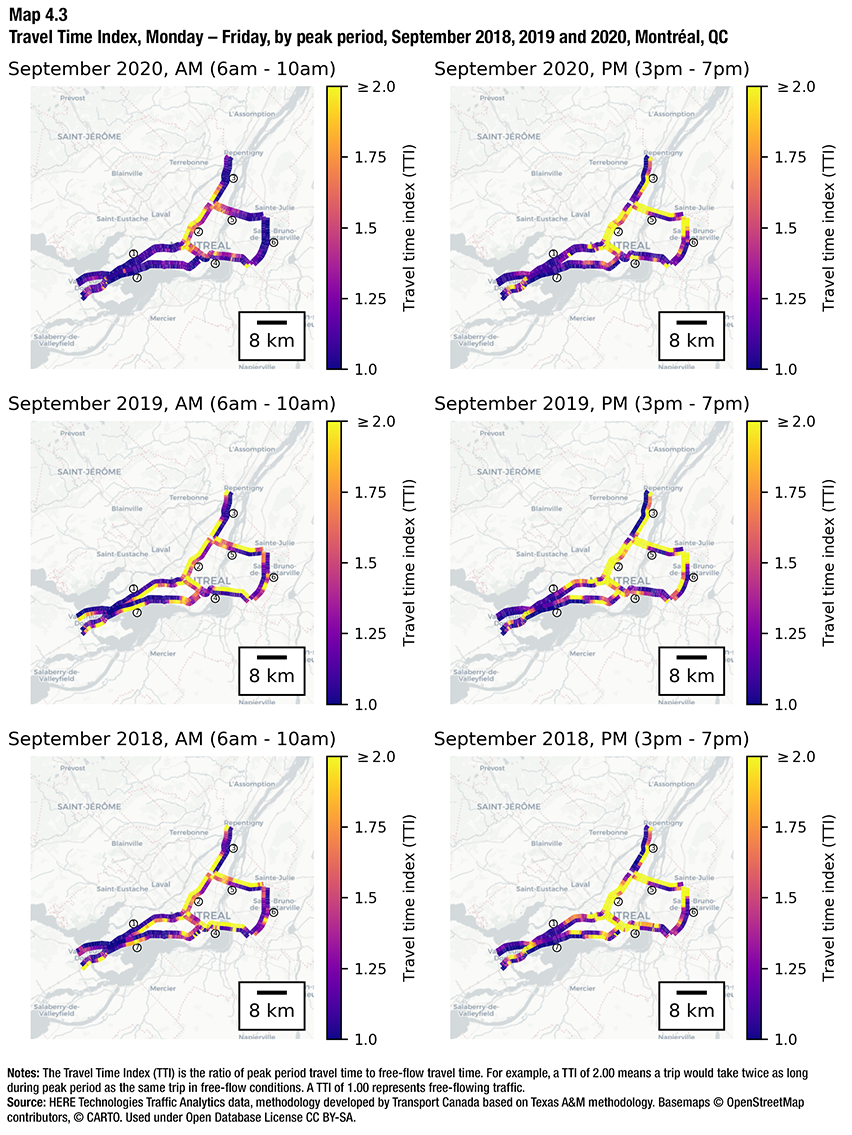
Description for Maps 4.1, 4.2 and 4.3
The maps of Montréal each contain seven corridors:
- Corridor 1 corresponds to highway A-40 between highway A-15 (Boulevard Décarie) in the east and highway A-30 in the west. Its approximate length is 33.5 kilometres.
- Corridor 2 corresponds to highway A-40 between highway A-25 in the east and highway A-15 (Boulevard Décarie) in the west. Its approximate length is 13.5 kilometres.
- Corridor 3 corresponds to highway A-40 between highway A-640 in the east and highway A-25 in the west. Its approximate length is 14 kilometres.
- Corridor 4 corresponds to highway A-10 and highway A-15 between highway A-30 in the east and highway A-40 in the west. Its approximate length is 21 kilometres.
- Corridor 5 corresponds to highway A-20 and highway A-25 between highway A-30 in the east and highway A-40 in the west. Its approximate length is 15 kilometres.
- Corridor 6 corresponds to highway A-30 between highway A-20 in the north and highway A-10 in the south. Its approximate length is 14.5 kilometres.
- Corridor 7 corresponds to highway A-20 between highway A-15 in the east and highway A-30 in the west. Its approximate length is 37.5 kilometres.
Each corridor is colour-coded to represent travel time index along its length. The dark purple colour represents a travel time index of 1.00 and the bright yellow colour represents a travel time index of 2.00 or greater. The aggregated corridor-level travel time index is shown in the table below.
Notes: The Travel Time Index (TTI) is the ratio of peak period travel time to free-flow travel time. For example, a TTI of 2.00 means a trip would take twice as long during peak period as the same trip in free-flow conditions. A TTI of 1.00 represents free-flowing traffic.
Source: HERE Technologies Traffic Analytics data, methodology developed by Transport Canada based on Texas A&M methodology. Basemaps © OpenStreetMap contributors, © CARTO. Used under Open Database License CC BY-SA.
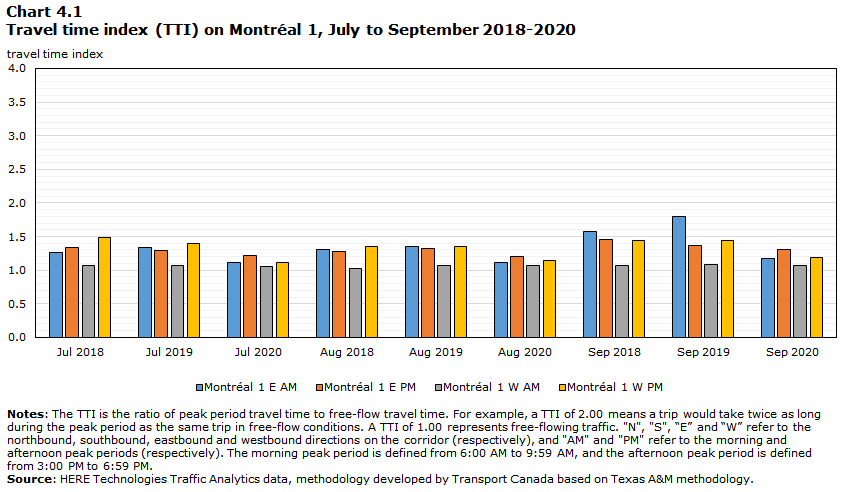
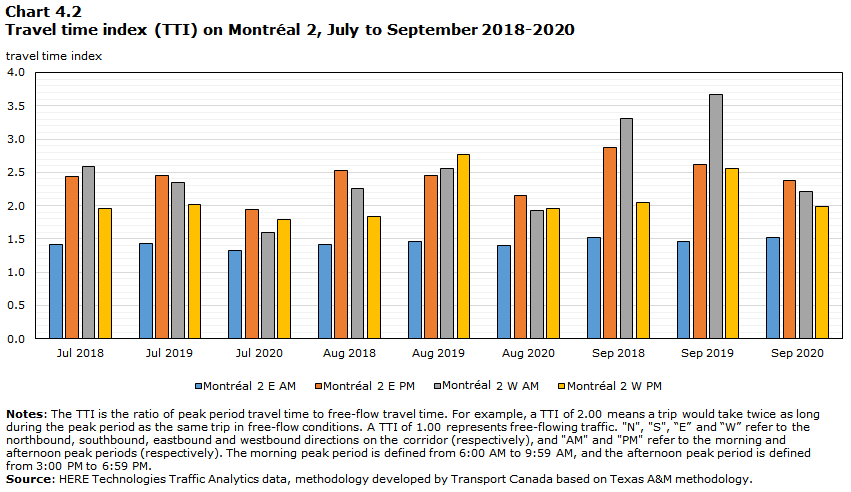
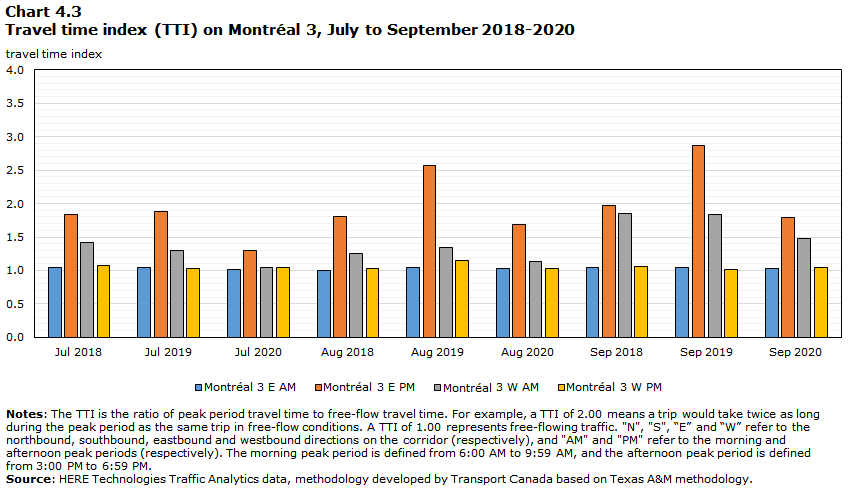
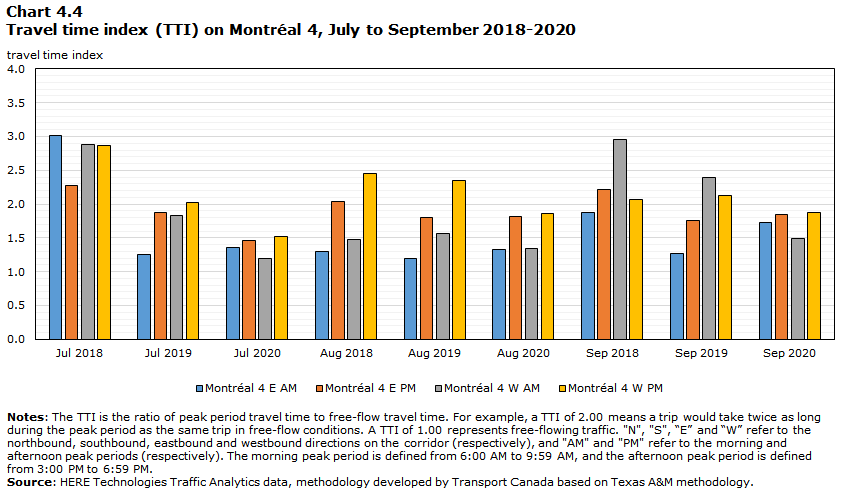
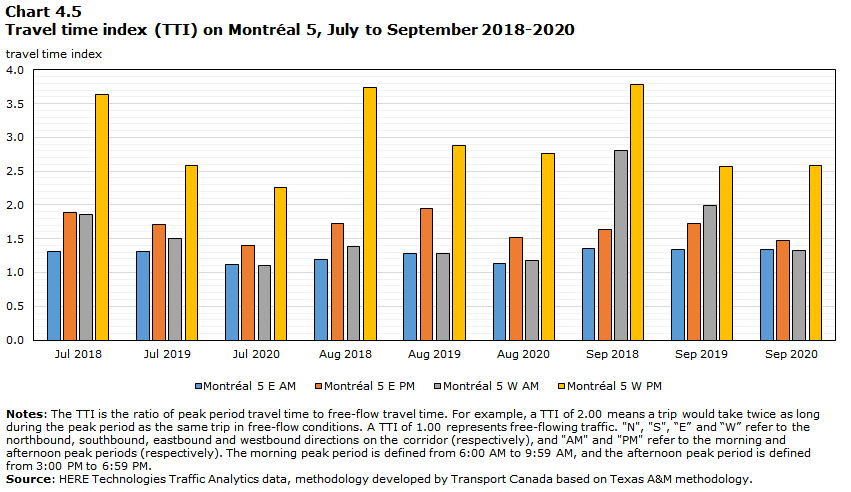
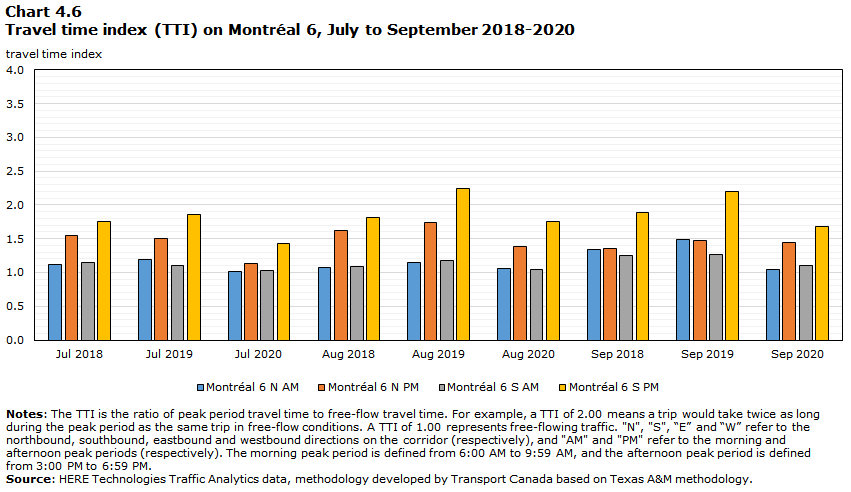
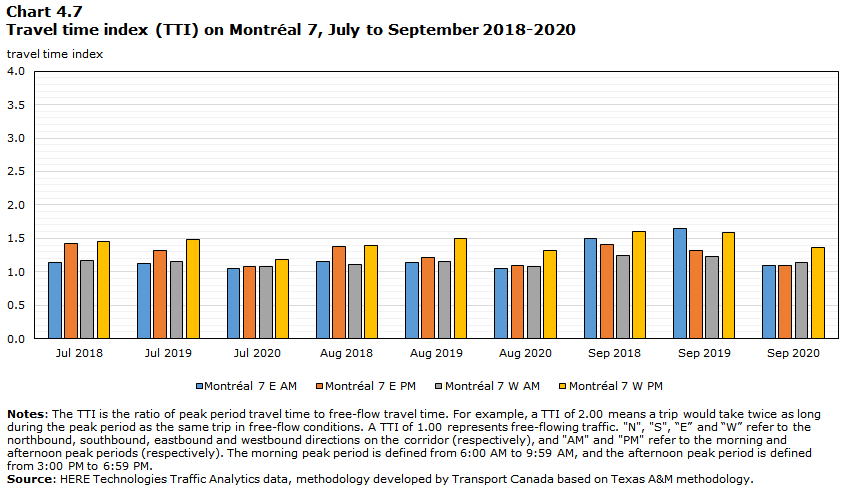
Data table for Charts 4.1, 4.2, 4.3, 4.4, 4.5, 4.6 and 4.7
| Corridor | Direction | Peak period | Jul 2018 | Jul 2019 | Jul 2020 | Aug 2018 | Aug 2019 | Aug 2020 | Sep 2018 | Sep 2019 | Sep 2020 |
|---|---|---|---|---|---|---|---|---|---|---|---|
| Montréal 1 | E | AM | 1.27 | 1.34 | 1.11 | 1.31 | 1.36 | 1.11 | 1.57 | 1.80 | 1.17 |
| PM | 1.34 | 1.29 | 1.22 | 1.28 | 1.32 | 1.20 | 1.46 | 1.36 | 1.31 | ||
| W | AM | 1.06 | 1.07 | 1.06 | 1.02 | 1.07 | 1.07 | 1.06 | 1.08 | 1.07 | |
| PM | 1.49 | 1.39 | 1.11 | 1.36 | 1.35 | 1.15 | 1.43 | 1.45 | 1.19 | ||
| Montréal 2 | E | AM | 1.41 | 1.43 | 1.32 | 1.42 | 1.46 | 1.41 | 1.52 | 1.47 | 1.51 |
| PM | 2.43 | 2.45 | 1.93 | 2.53 | 2.45 | 2.16 | 2.87 | 2.61 | 2.38 | ||
| W | AM | 2.59 | 2.35 | 1.60 | 2.25 | 2.55 | 1.93 | 3.31 | 3.66 | 2.21 | |
| PM | 1.96 | 2.02 | 1.79 | 1.84 | 2.77 | 1.96 | 2.04 | 2.56 | 1.98 | ||
| Montréal 3 | E | AM | 1.05 | 1.05 | 1.02 | 1.00 | 1.04 | 1.02 | 1.05 | 1.04 | 1.03 |
| PM | 1.84 | 1.88 | 1.30 | 1.81 | 2.57 | 1.68 | 1.97 | 2.87 | 1.79 | ||
| W | AM | 1.41 | 1.30 | 1.04 | 1.26 | 1.35 | 1.13 | 1.85 | 1.84 | 1.47 | |
| PM | 1.08 | 1.03 | 1.04 | 1.02 | 1.15 | 1.03 | 1.05 | 1.01 | 1.05 | ||
| Montréal 4 | E | AM | 3.02 | 1.25 | 1.36 | 1.30 | 1.19 | 1.33 | 1.88 | 1.28 | 1.73 |
| PM | 2.27 | 1.88 | 1.47 | 2.04 | 1.80 | 1.82 | 2.21 | 1.75 | 1.85 | ||
| W | AM | 2.88 | 1.83 | 1.20 | 1.48 | 1.57 | 1.35 | 2.95 | 2.40 | 1.50 | |
| PM | 2.86 | 2.02 | 1.52 | 2.45 | 2.35 | 1.86 | 2.07 | 2.13 | 1.87 | ||
| Montréal 5 | E | AM | 1.30 | 1.31 | 1.12 | 1.19 | 1.27 | 1.14 | 1.36 | 1.34 | 1.33 |
| PM | 1.88 | 1.71 | 1.40 | 1.73 | 1.94 | 1.51 | 1.64 | 1.73 | 1.48 | ||
| W | AM | 1.86 | 1.50 | 1.11 | 1.39 | 1.28 | 1.18 | 2.81 | 1.99 | 1.32 | |
| PM | 3.64 | 2.58 | 2.26 | 3.74 | 2.87 | 2.76 | 3.78 | 2.57 | 2.58 | ||
| Montréal 6 | N | AM | 1.12 | 1.19 | 1.01 | 1.07 | 1.15 | 1.05 | 1.34 | 1.48 | 1.05 |
| PM | 1.55 | 1.50 | 1.13 | 1.62 | 1.74 | 1.38 | 1.36 | 1.48 | 1.44 | ||
| S | AM | 1.15 | 1.10 | 1.03 | 1.08 | 1.18 | 1.05 | 1.24 | 1.27 | 1.10 | |
| PM | 1.75 | 1.86 | 1.43 | 1.81 | 2.24 | 1.76 | 1.89 | 2.21 | 1.69 | ||
| Montréal 7 | E | AM | 1.14 | 1.13 | 1.05 | 1.15 | 1.14 | 1.05 | 1.50 | 1.64 | 1.10 |
| PM | 1.42 | 1.31 | 1.08 | 1.38 | 1.22 | 1.09 | 1.41 | 1.32 | 1.10 | ||
| W | AM | 1.17 | 1.15 | 1.08 | 1.11 | 1.15 | 1.08 | 1.24 | 1.23 | 1.14 | |
| PM | 1.45 | 1.49 | 1.18 | 1.40 | 1.49 | 1.32 | 1.60 | 1.58 | 1.36 | ||
| Notes: The TTI is the ratio of peak period travel time to free-flow travel time. For example, a TTI of 2.00 means a trip would take twice as long during the peak period as the same trip in free-flow conditions. A TTI of 1.00 represents free-flowing traffic. "N", "S", “E” and “W” refer to the northbound, southbound, eastbound and westbound directions on the corridor (respectively), and "AM" and "PM" refer to the morning and afternoon peak periods (respectively). The morning peak period is defined from 6:00 AM to 9:59 AM, and the afternoon peak period is defined from 3:00 PM to 6:59 PM. Source: HERE Technologies Traffic Analytics data, methodology developed by Transport Canada based on Texas A&M methodology. |